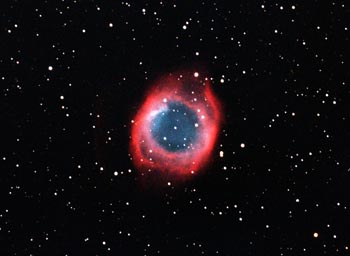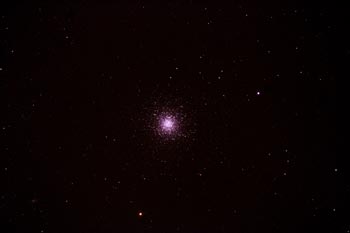|
Deep Sky Images
By Chris Vedeler
|
NGC 281 The Pacman
Nebula

Click on the image for high resolution
NGC 281 The Pacman Nebula 9500
light years distant in the constellation Cassiopea
Telescope:
Astro-Physics 160 EDF
+ Astro-Physics Photographic-Visual
Telecompressor (0.75x) (27TVPH), effective 900mm focal length,
f/5.625
Mount: Astro-Physics
900 GTO2
guided using my Orion
80mm f/11.4 Guidescope and my Meade
DSI II as an autoguider using PHD Guiding
software.
Camera: Baader
filter Modified Canon EOS XT 350, 8MP with Orion
Skyglow Broadband filter.
Exposures: 21 x 180 second exposures + 5 x 480 second exposures
Processing: Stacked, Dark subtract and Flat fielded in DeepSkyStacker. Color balance, level balance, unsharp mask, other image
cleanup and converted to JPG in Photoshop. Cleaned up with NEAT
image.
Taken: Scottsdale, AZ October
1st, 2008
Notes: Considering this image was taken under heavy light
pollution and I was only able to get 1 480 second dark frame it came out
pretty good. I hope to retake this object later in October 2008
under dark skies.
|
M42 The Orion Nebula

Click on the image for high resolution
M42 The Orion Nebula 1600 light
years distant in the constellation Orion
Telescope:
Astro-Physics 160 EDF,
1200mm focal length, f7/5
Mount: Orion Atlas
EQ-G using EQMOD
guided using my Orion
80mm f/11.4 Guidescope and my Meade
DSI II as an autoguider using PHD Guiding
software.
Camera: Baader
filter Modified Canon EOS XT 350, 8MP.
Exposures: 6x10 seconds, 6x30 seconds, 10x3 minutes, 8x8 minutes (Total
1 hour 38 minutes.)
Processing: Stacked, Dark subtract and Flat fielded in DeepSkyStacker. Color balance, level balance, unsharp mask, other image
cleanup and converted to JPG in Photoshop. Re-processed
9/23/08.
Taken: Farnsworth
Ranch, AZ at the All Arizona Star Party October 14th 2007
Notes: Careful focus and very accurate guiding yielded this
image. It was taken between 1 AM and 3 AM with 45 degree F temperatures.
I rate this as my best astro-photo yet and the first image I have taken
that begins to really show what the AP160 is capable of doing.
|
NGC 7293 The Helix Nebula

Click on the image for high resolution
NGC 7293 The Helix Nebula 450 light
years distant in the constellation Aquarius
Telescope:
Astro-Physics 160 EDF,
1200mm focal length, f7/5
Mount: Orion Atlas
EQ-G using EQMOD
guided using my Orion
80mm f/11.4 Guidescope and my Meade
DSI II as an autoguider using PHD Guiding
software.
Camera: Baader
filter Modified Canon EOS XT 350, 8MP.
Exposures: 3x10 minute exposures.
Processing: Stacked, Dark subtract and Flat fielded in DeepSkyStacker. Color balance, level balance, unsharp mask, other image
cleanup and converted to JPG in Photoshop.
Taken: Farnsworth
Ranch, AZ at the All Arizona Star Party October 13th 2007
Notes: I was planning on many more exposures for this one,
but it was crossing the meridian at the time and the winds were gusting
enough to really shake the mount. Imaging was cut short as I was
starting to feel tired and I wanted to do some visual observing on the
first night of the All Arizona Star Party. The seeing was so-so.
|
|
M27 The Dumbbell Nebula
Click on the image for high resolution
M27 The Dumbbell Nebula 1360 light
years distant in the constellation Vulpecula
Telescope:
Astro-Physics 160 EDF,
1200mm focal length, f7/5
Mount: AP900 GTO guided using my Orion
80mm f/11.4 Guidescope using a Meade
DSI II as an autoguider using PHD Guiding
software.
Camera: Baader
filter Modified Canon EOS XT 350, 8MP. Plus a 2" Orion DeepSky
Broadband filter.
Exposures: 15x3min (Total 45min.)
Processing: Stacked, Dark subtract and Flat fielded in DeepSkyStacker. Color balance, level balance, unsharp mask, other image
cleanup and converted to JPG in Photoshop.
Taken: Scottsdale, AZ
August 19th, 2008
Notes: This was a practice shot using my new AP900 mount and
the Orion light pollution filter. The stacking process bloated the
stars slightly, but overall the results were good.
|
M16 The Eagle Nebula
Click on the image for high resolution
M16 the Eagle Nebula 7,000 light
years distant in the constellation Serpens
Telescope:
Astro-Physics 160 EDF,
1200mm focal length, f7/5
Mount: Orion Atlas
EQ-G using EQMOD,
guided with an Orion
80mm Short Tube refractor and unmodified
Philips SPC900NC Webcam using PHD
Guiding software.
Camera: Baader
filter Modified Canon EOS XT 350, 8MP.
Exposures: 4x5min, 20x2min, 6x3min (Total 1 hour 21 min.)
Processing: Stacked, Dark subtract and Flat fielded in DeepSkyStacker. Color balance, level balance, unsharp mask, other image
cleanup and converted to JPG in Photoshop.
Taken: Scottsdale, AZ
June 23rd 2007
Notes: My first serious attempt at long exposure
astrophotography since getting my AP160. It was with this shot I
realized the potential of shooting at my urban location. |
M17 The Swab Nebula

Click on the image for high resolution
M17 The Swab Nebula 5000 light
years distant in the constellation Sagittarius
Telescope:
Astro-Physics 160 EDF,
1200mm focal length, f7/5
Mount: Orion Atlas
EQ-G using EQMOD
guided using my Orion
80mm f/11.4 Guidescope and a stock Philips SPC900NC Webcam
using PHD Guiding
software.
Camera: Baader
filter Modified Canon EOS XT 350, 8MP.
Exposures: 16x2min (Total 36min.)
Processing: Stacked, Dark subtract and Flat fielded in DeepSkyStacker. Color balance, level balance, unsharp mask, other image
cleanup and converted to JPG in Photoshop.
Taken: Scottsdale, AZ
July 8th 2007
Notes: Not a great shot, but it was taken low through some of
my worst local light pollution.
Also the camera has a lot of noise when it is over 100F. I hope to
get a better image of this beautiful nebula next summer at a higher and
cooler location (2008).
|
|
M51 The Whirlpool Galaxy
Click on the image for high resolution
M51 the Whirlpool galaxy 37
million light years distant in the constellation Canes Venatici
Telescope:
Astro-Physics 160 EDF,
1200mm focal length, f/7.5
Mount: Orion Atlas
EQ-G using EQMOD,
guided with an Orion
80mm Short Tube refractor and unmodified
Philips SPC900NC Webcam using PHD
Guiding software.
Camera: Baader
filter Modified Canon EOS XT 350, 8MP.
Exposures: 10x2min. (Total 20min.)
Processing: Stacked, Dark subtract in DeepSkyStacker. Color
balance, level balance, unsharp mask, other image cleanup and converted to
JPG in Photoshop.
Taken: Scottsdale, AZ June 20th 2007
Notes: Since M51 was high in the evening sky, I decided to
see what I could get. It was hear I learned that 2 minute exposures
was about as long as I could go under my light polluted urban skies.
|
M13 The Great globular cluster in Hercules
Click on the image for high resolution
M13 The Great globular cluster in
Hercules 25,100 light years distant in the constellation
Hercules
Telescope:
Astro-Physics 160 EDF,
1200mm focal length, f7/5
Mount: Orion Atlas
EQ-G using EQMOD,
guided with an Orion
80mm Short Tube refractor and unmodified
Philips SPC900NC Webcam using PHD
Guiding software.
Camera: Baader
filter Modified Canon EOS XT 350, 8MP.
Exposures: 6x30sec. (Total 3min.)
Processing: Stacked, Dark subtract in DeepSkyStacker. Color
balance, level balance, unsharp mask, other image cleanup and converted to
JPG in Photoshop.
Taken: Scottsdale, AZ June 19th 2007
Notes: My first astro-photo using my new Canon EOS XT 350
|
Comet 17/P Holmes

Click on the image for high resolution
Comet 17/P Holmes 2AU (twice the
distance from the Earth to the Sun).
Telescope:
Astro-Physics 160 EDF,
1200mm focal length, f7/5
Mount: Orion Atlas
EQ-G using EQMOD
guided using my Orion
80mm f/11.4 Guidescope and my Meade
DSI II as an autoguider using PHD Guiding
software.
Camera: Baader
filter Modified Canon EOS XT 350, 8MP.
Exposures: 10 60 second exposures
Processing: Stacked, Dark subtract and Flat fielded in DeepSkyStacker. Color balance, level balance, unsharp mask, other image
cleanup and converted to JPG in Photoshop.
Taken: Scottsdale, AZ November
2nd 2007
Notes: The most exciting comet this year. It was a
very faint known comet that suddenly burst 1 million times brighter than
expected in the span of a few days. As of November 3rd this ball of
cometary debris is almost the size of the Sun!
The Earth is between the comet and the Sun, and so no tail is
visible.
|
Home
Christopher Vedeler 2007

|
|